Jinja Im Working on Resume Upload
Flask comes packaged with the powerful Jinja templating language.
For those who take non been exposed to a templating language before, such languages essentially comprise variables equally well every bit some programming logic, which when evaluated (or rendered into HTML) are replaced with actual values.
The variables and/or logic are placed between tags or delimiters. For instance, Jinja templates use {% ... %} for expressions or logic (like for loops), while {{ ... }} is used for outputting the results of an expression or a variable to the end user. The latter tag, when rendered, is replaced with a value or values, and is seen by the end user.
Quick Examples
Make sure you take Jinja installed before running these examples (pip install jinja2):
>>>
>>> from jinja2 import Template >>> t = Template ( "Hello {{ something }}!" ) >>> t . render ( something = "World" ) u'Hello Earth!' >>> t = Template ( "My favorite numbers: { % f or n in range(ane,10) %}{{northward}} " "{ % e ndfor %}" ) >>> t . render () u'My favorite numbers: ane two 3 4 5 6 7 viii nine ' Discover how the actual output rendered to the user falls within the tags.
Flask Examples
The code can be establish here.
Create the following project structure:
├── requirements.txt ├── run.py └── templates Activate a virtualenv, then install flask:
Add the following code to run.py:
from flask import Flask , render_template app = Flask ( __name__ ) @app . route ( "/" ) def template_test (): render render_template ( 'template.html' , my_string = "Wheeeee!" , my_list = [ 0 , 1 , two , 3 , 4 , 5 ]) if __name__ == '__main__' : app . run ( debug = True ) Here, we are establishing the route /, which renders the template template.html via the part render_template(). This function must take a template name. Optionally, you tin pass in keyword arguments to the template, like in the example with my_string and my_list.
Add together the template:
<!DOCTYPE html> < html > < head > < title >Flask Template Example</ title > < meta name = "viewport" content = "width=device-width, initial-scale=one.0" > < link href = "http://netdna.bootstrapcdn.com/bootstrap/iii.0.0/css/bootstrap.min.css" rel = "stylesheet" media = "screen" > < fashion type = "text/css" > . container { max-width : 500 px ; padding-top : 100 px ; } </ style > </ caput > < body > < div grade = "container" > < p >My string: {{my_string}}</ p > < p >Value from the list: {{my_list[3]}}</ p > < p >Loop through the list:</ p > < ul > {% for n in my_list %} < li >{{northward}}</ li > {% endfor %} </ ul > </ div > < script src = "http://code.jquery.com/jquery-1.10.ii.min.js" ></ script > < script src = "http://netdna.bootstrapcdn.com/bootstrap/3.0.0/js/bootstrap.min.js" ></ script > </ body > </ html > Salvage this as template.html in the templates directory. Observe the template tags. Can you estimate the output before yous run the app?
Run the following:
You should see the following:
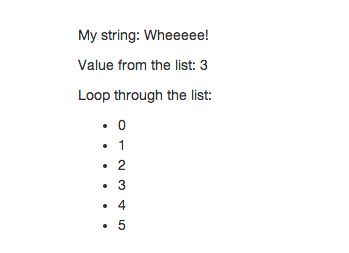
Template Inheritance
Templates commonly accept advantage of inheritance, which includes a unmarried base template that defines the bones construction of all subsequent child templates. Yous use the tags {% extends %} and {% cake %} to implement inheritance.
The use case for this is simple: as your application grows, and you continue adding new templates, you volition demand to keep common code (like an HTML navigation bar, Javascript libraries, CSS stylesheets, and so forth) in sync, which tin can be a lot of piece of work. Using inheritance, we can move those common pieces to a parent/base template so that we tin can create or edit such lawmaking once, and all child templates will inherent that lawmaking.
Let'southward add inheritance to our example.
Create the base (or parent) template:
<!DOCTYPE html> < html > < head > < title >Flask Template Case</ title > < meta proper noun = "viewport" content = "width=device-width, initial-scale=ane.0" > < link href = "http://netdna.bootstrapcdn.com/bootstrap/three.0.0/css/bootstrap.min.css" rel = "stylesheet" media = "screen" > < style type = "text/css" > . container { max-width : 500 px ; padding-top : 100 px ; } h2 { color : red ;} </ manner > </ head > < body > < div class = "container" > < h2 >This is part of my base template</ h2 > < br > {% block content %}{% endblock %} < br > < h2 >This is function of my base template</ h2 > </ div > < script src = "http://code.jquery.com/jquery-1.10.ii.min.js" ></ script > < script src = "http://netdna.bootstrapcdn.com/bootstrap/iii.0.0/js/bootstrap.min.js" ></ script > </ body > </ html > Save this as layout.html.
Did you notice the {% cake %} tags? This defines a block (or area) that kid templates tin can fill in. Further, this just informs the templating engine that a child template may override the block of the template.
Allow's do that.
Update template.html:
{% extends "layout.html" %} {% block content %} < h3 > This is the start of my child template</ h3 > < br > < p >My cord: {{my_string}}</ p > < p >Value from the list: {{my_list[3]}}</ p > < p >Loop through the list:</ p > < ul > {% for n in my_list %} < li >{{northward}}</ li > {% endfor %} </ ul > < h3 > This is the end of my child template</ h3 > {% endblock %} So, the {% extends %} informs the templating engine that this template "extends" another template, layout.html. This establishes the link betwixt the templates.
Run it. Yous should run into this:

One common use case is to add a navigation bar.
Add the post-obit code to the base template, just later on the opening <trunk> tag:
< nav class = "navbar navbar-inverse" role = "navigation" > < div course = "container-fluid" > < div grade = "navbar-header" > < button type = "push" class = "navbar-toggle" data-toggle = "collapse" data-target = "#bs-example-navbar-plummet-1" > < bridge form = "sr-only" >Toggle navigation</ span > < span class = "icon-bar" ></ bridge > < span class = "icon-bar" ></ span > < span class = "icon-bar" ></ span > </ button > < a class = "navbar-make" href = "/" >Jinja!</ a > </ div > < div class = "plummet navbar-collapse" id = "bs-example-navbar-collapse-1" > < ul form = "nav navbar-nav" > < li class = "active" >< a href = "#" >Link</ a ></ li > < li >< a href = "#" >Link</ a ></ li > </ ul > < form grade = "navbar-form navbar-left" role = "search" > < div grade = "course-group" > < input type = "text" grade = "form-command" placeholder = "Search" > </ div > < button blazon = "submit" class = "btn btn-default" >Submit</ button > </ class > < ul course = "nav navbar-nav navbar-correct" > < li >< a href = "#" >Link</ a ></ li > < li class = "dropdown" > < a href = "#" form = "dropdown-toggle" data-toggle = "dropdown" >Dropdown < b course = "caret" ></ b ></ a > < ul class = "dropdown-card" > < li >< a href = "#" >Activeness</ a ></ li > < li >< a href = "#" >Another action</ a ></ li > < li >< a href = "#" >Something else hither</ a ></ li > < li class = "divider" ></ li > < li >< a href = "#" >Separated link</ a ></ li > </ ul > </ li > </ ul > </ div > <!-- /.navbar-plummet --> </ div > <!-- /.container-fluid --> </ nav > At present, every single child template that extends from the base will have the same navigation bar. To steal a line from Coffee philosophy: "Write once, employ anywhere."
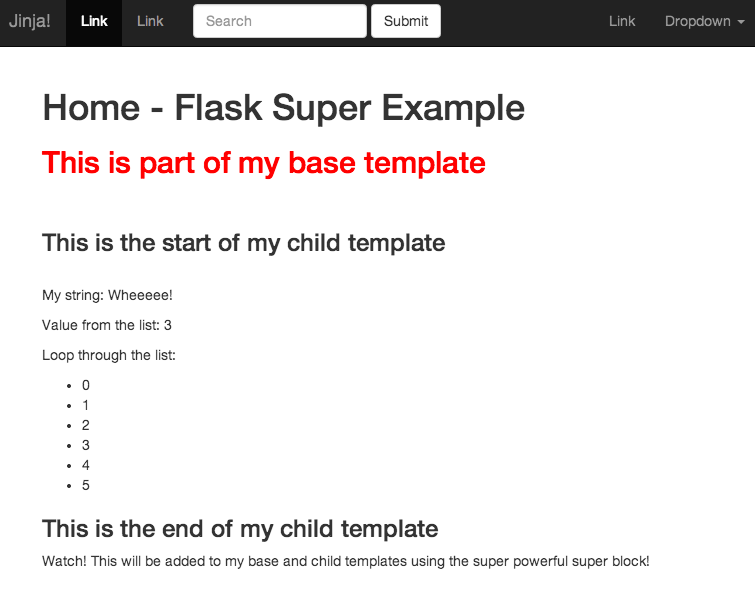
Super Blocks
If you demand to render a block from the base template, use a super block:
Add together a footer to the base of operations template:
< div form = "footer" > {% cake footer %} Sentinel! This will exist added to my base and child templates using the super powerful super cake! < br > < br > {% endblock %} </ div > Here's the updated code:
<!DOCTYPE html> < caput > < title >Flask Template Example</ title > < meta proper noun = "viewport" content = "width=device-width, initial-scale=1.0" > < link href = "http://netdna.bootstrapcdn.com/bootstrap/3.0.0/css/bootstrap.min.css" rel = "stylesheet" media = "screen" > < mode type = "text/css" > . container { max-width : 500 px ; padding-top : 100 px ; } h2 { color : carmine ;} </ style > </ head > < torso > < div class = "container" > < h2 >This is function of my base template</ h2 > < br > {% block content %}{% endblock %} < br > < h2 >This is part of my base template</ h2 > < br > < div grade = "footer" > {% block footer %} Watch! This volition exist added to my base and kid templates using the super powerful super block! < br > < br > < br > {% endblock %} </ div > </ div > < script src = "http://code.jquery.com/jquery-1.10.2.min.js" ></ script > < script src = "http://netdna.bootstrapcdn.com/bootstrap/three.0.0/js/bootstrap.min.js" ></ script > </ body > </ html > Run the app. You lot should see that the footer is simply part of the base:
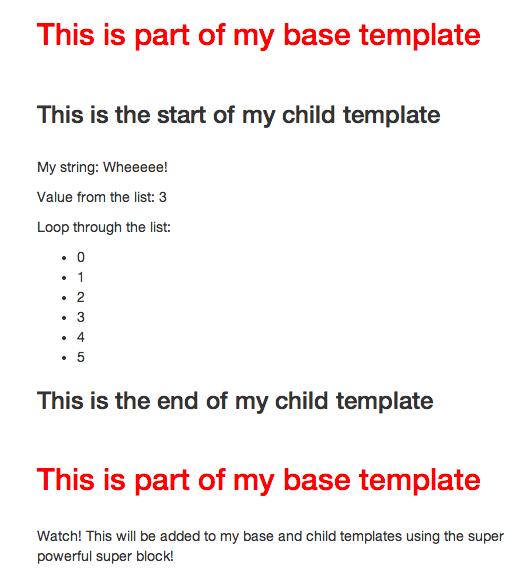
Now, add the super block to template.html:
{% extends "layout.html" %} {% block content %} < h3 > This is the start of my child template</ h3 > < br > < p >My string: {{my_string}}</ p > < p >Value from the list: {{my_list[3]}}</ p > < p >Loop through the list:</ p > < ul > {% for n in my_list %} < li >{{north}}</ li > {% endfor %} </ ul > < h3 > This is the stop of my kid template</ h3 > {% block footer %} {{super()}} {% endblock %} {% endblock %} Check it out in your browser:
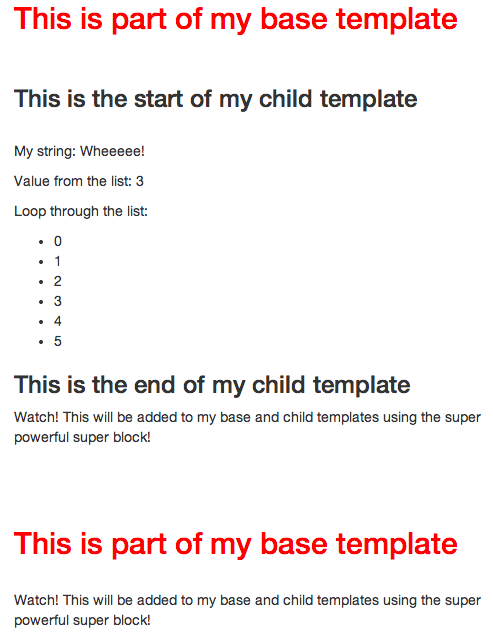
The super cake is used for common code that both the parent and child templates share, such equally the <title>, where both templates share part of the championship. Then, you would just need to laissez passer in the other part. It could also be used for a heading.
Here's an instance:
Parent
{% block heading %} < h1 >{% block page %}{% endblock %} - Flask Super Instance</ h1 > {% endblock %} Child
{% block page %}Home{% endblock %} {% cake heading %} {{ super() }} {% endblock %} Let's encounter that in action:
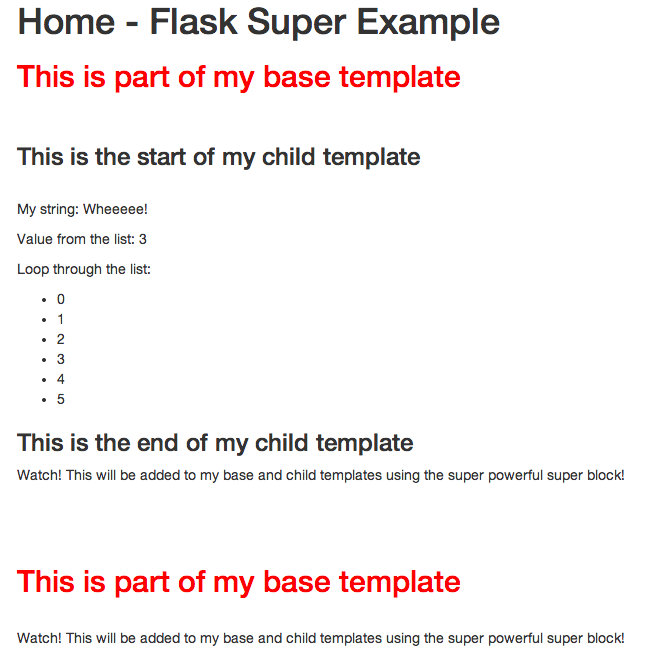
Run across what happens when y'all remove {% block page %}Home{% endblock %} from the child template.
Instead of difficult coding the name of the template, let's get in dynamic.
Update the two code snippets in template.html:
{% block title %}{{championship}}{% endblock %} {% block page %}{{title}}{% endblock %} Now, we need to pass in a title variable to our template from our controller, run.py:
@app . route ( "/" ) def template_test (): return render_template ( 'template.html' , my_string = "Wheeeee!" , my_list = [ 0 , 1 , ii , 3 , iv , 5 ], title = "Domicile" ) Examination this out.
Macros
In Jinja, we tin can use macros to abstract commonly used code snippets that are used over and over to not repeat ourselves. For example, it'due south common to highlight the link of the electric current page on the navigation bar (active link). Otherwise, we'd accept to use if/elif/else statements to determine the active link. Using macros, nosotros can abstract out such code into a split file.
Add a macros.html file to the templates directory:
{% macro nav_link(endpoint, proper noun) %} {% if request.endpoint.endswith(endpoint) %} < li class = "agile" >< a href = "{{ url_for(endpoint) }}" >{{proper name}}</ a ></ li > {% else %} < li >< a href = "{{ url_for(endpoint) }}" >{{proper noun}}</ a ></ li > {% endif %} {% endmacro %} Here, we're using Flask'southward request object, which is part of Jinja by default, to check the requested endpoint, and then assigning the active class to that endpoint.
Update the unordered listing with the nav navbar-nav grade in the base template:
< ul form = "nav navbar-nav" > {{ nav_link('dwelling house', 'Home') }} {{ nav_link('most', 'About') }} {{ nav_link('contact', 'Contact United states of america') }} </ ul > Besides, make certain to add the import at the top of the template: {% from "macros.html" import nav_link with context %}.
Detect how nosotros're calling the nav-link macro and passing it two arguments: the endpoint (which comes from our controller) and the text we want displayed.
Finally, let's add three new endpoints to the controller:
@app . route ( "/home" ) def dwelling house (): render render_template ( 'template.html' , my_string = "Wheeeee!" , my_list = [ 0 , i , two , 3 , four , 5 ], title = "Dwelling" ) @app . road ( "/about" ) def about (): return render_template ( 'template.html' , my_string = "Wheeeee!" , my_list = [ 0 , ane , 2 , 3 , 4 , five ], title = "Nigh" ) @app . road ( "/contact" ) def contact (): render render_template ( 'template.html' , my_string = "Wheeeee!" , my_list = [ 0 , 1 , 2 , 3 , iv , 5 ], championship = "Contact U.s." ) Refresh the page. Test out the links at the top. Does the electric current page get highlighted? It should.

Custom Filters
Jinja uses filters to alter variables, mostly for formatting purposes.
Here'southward an example:
This will circular the num variable. And then, if we pass the argument num=46.99 into the template, then 47.0 will be outputted.
As you can tell, yous specify the variable and then a pipage (|), followed by the filter. Bank check out this link for the list of filters already included within Jinja. In some cases, you tin specify optional arguments in parentheses.
Here'due south an example:
This will join a listing by the comma delimiter.
Exam this out. Add the post-obit line to template.html
< p >Same listing with a filter: {{ my_list|join(', ') }}</ p > Now, besides the built-in filters, we tin create our ain.
Allow's add 1 of our own. I common example is a custom datetime filter.
Add together the following lawmaking to our controller later we create the app, app = Flask(__name__):
@app . template_filter () def datetimefilter ( value , format = '%Y/%m/ %d %H:%M' ): """Catechumen a datetime to a different format.""" render value . strftime ( format ) app . jinja_env . filters [ 'datetimefilter' ] = datetimefilter Using the @app.template_filter() decorator, we are registering the datetimefilter() function as a filter.
Next, we are adding the filter to the Jinja environment, making it attainable. At present information technology'due south ready for use.
Add the following lawmaking to our child template:
< h4 >Current date/fourth dimension: {{ current_time | datetimefilter }}</ h4 > Finally, but pass in the datetime to our template:
current_time = datetime . datetime . now () Test it.
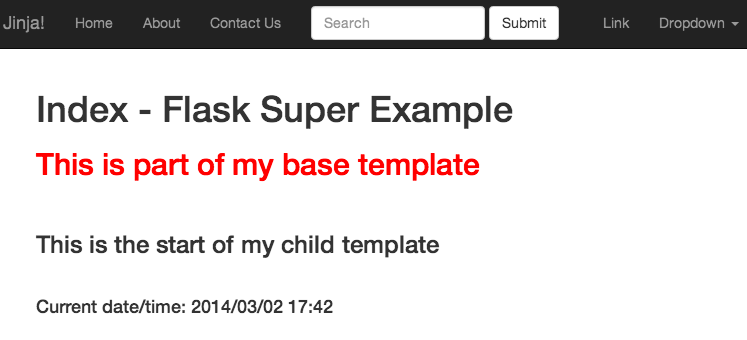
Determination
That'due south it. Grab the sample code hither. Did I miss anything? Leave a comment below.
upchurchmagas2000.blogspot.com
Source: https://realpython.com/primer-on-jinja-templating/
0 Response to "Jinja Im Working on Resume Upload"
Post a Comment